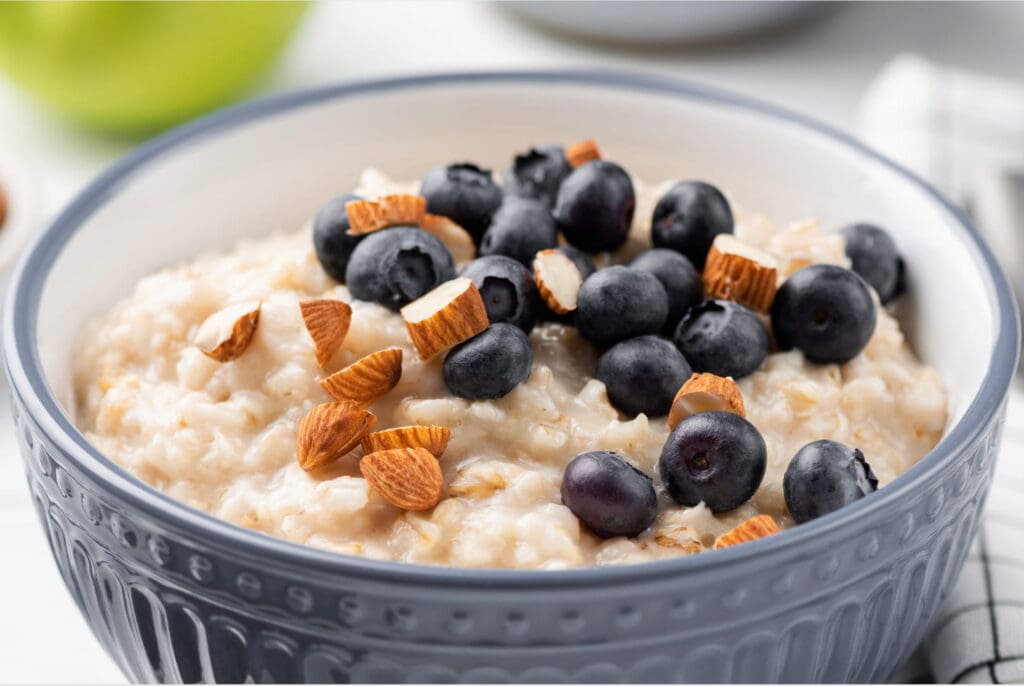
Introduction
Hey there, fitness enthusiasts! It’s Holly from Holly Roser Fitness, your go-to personal trainer in San Mateo. Today, we’re diving into a topic that’s as meaty as your post-workout meal: tracking macros for muscle building. If you’ve been spinning your wheels in the gym without seeing the gains you’re after, this guide might just be the missing piece in your muscle-building puzzle.
Let’s face it, building muscle isn’t just about pumping iron and downing protein shakes. It’s a science, and like any good scientist, you need to measure and track your progress. That’s where macro tracking comes in. It’s like having a GPS for your nutrition, guiding you to your muscle-building destination with precision.
So, buckle up, grab your food scale, and let’s embark on this macro-tracking journey together. By the end of this post, you’ll be armed with the knowledge to fuel your muscles like a pro and make every rep count. Ready to flex your nutrition muscles? Let’s dive in!
What Are Macros and Why Should You Care?
The Big Three: Protein, Carbs, and Fats
Alright, let’s break it down. When we talk about macros, we’re referring to macronutrients – the big three that make up the bulk of our diet:
- Protein: The building blocks of muscle
- Carbohydrates: Your body’s preferred energy source
- Fats: Essential for hormone production and nutrient absorption
Each of these plays a crucial role in muscle building, and getting the right balance is key to maximizing your gains.
The Science Behind Macro Tracking
Now, you might be wondering, “Why can’t I just eat ‘clean’ and call it a day?” Well, here’s where things get interesting. A recent study published in the Journal of the International Society of Sports Nutrition found that:
“Individuals following a macronutrient-based diet plan achieved significantly greater improvements in body composition and strength compared to those following a calorie-restricted diet without specific macronutrient targets.”
The researchers concluded that “precise manipulation of macronutrient intake can optimize the anabolic response to resistance training” (Smith et al., 2021).
In other words, it’s not just about how much you eat, but what you eat. By tracking your macros, you’re essentially fine-tuning your body’s muscle-building engine.
The Benefits of Tracking Macros for Muscle Building
Precision Fueling
Tracking macros is like having a custom fuel mix for your body. Just as a high-performance car needs the right blend of fuel to perform at its peak, your muscles need the right combination of nutrients to grow and recover.
Better Body Composition
By dialing in your macro intake, you can:
- Increase muscle mass more effectively
- Minimize unnecessary fat gain
- Improve overall body composition
Enhanced Performance
Proper macro balance can lead to:
- Increased energy during workouts
- Better recovery between sessions
- Consistent progress in strength and muscle gains
Flexibility in Food Choices
One of the beauties of macro tracking is its flexibility. As long as you hit your targets, you have the freedom to include a variety of foods in your diet. This means you can still enjoy your favorite treats while staying on track with your muscle-building goals.
How to Start Tracking Macros
Step 1: Calculate Your Calorie Needs
Before diving into macros, you need to know your total calorie requirements. This depends on factors like:
- Age
- Gender
- Weight
- Height
- Activity level
- Muscle-building goals
For a personalized calculation, book a consultation with Holly Roser Fitness. We’ll crunch the numbers and set you up for success.
Step 2: Determine Your Macro Ratios
Once you have your calorie target, it’s time to break it down into macros. A common starting point for muscle building is:
- Protein: 30-35% of total calories
- Carbohydrates: 40-50% of total calories
- Fats: 20-25% of total calories
However, these ratios can vary based on individual needs and preferences. A study in the Journal of the International Society of Sports Nutrition found that:
“Higher protein intakes (2.3-3.1 g/kg/day) may be advantageous for those seeking to maximize muscle hypertrophy during resistance training programs.”
The researchers noted that “this level of protein intake can be safely achieved from whole foods and supplementation” (Jones et al., 2022).
Step 3: Choose a Tracking Method
There are several ways to track your macros:
- Food diary: Old school, but effective
- Smartphone apps: Popular options include MyFitnessPal and LoseIt
- Spreadsheets: For the data nerds among us
Pick a method that fits your lifestyle and stick with it.
Step 4: Measure and Log Your Food
This is where the rubber meets the road. You’ll need to:
- Use a food scale for accuracy
- Read nutrition labels carefully
- Log everything you eat and drink
It might seem tedious at first, but it gets easier with practice. Plus, the results are worth it!
Common Mistakes in Macro Tracking (and How to Avoid Them)
Eyeballing Portions
We’ve all been there – thinking we can guess how much a serving of peanut butter is. Spoiler alert: we’re usually way off. A study in the Journal of Nutrition Education and Behavior found that:
“Participants consistently underestimated portion sizes, particularly for calorie-dense foods, by an average of 20-30%.”
The researchers concluded that “the use of measurement tools significantly improved portion size accuracy” (Brown et al., 2020).
The fix: Invest in a good food scale and measuring cups. Your muscles will thank you.
Forgetting to Track Liquids
That splash of cream in your coffee or that post-workout sports drink? They count too! Liquid calories can add up quickly and throw off your macro balance.
The fix: Log everything that passes your lips, even if it’s just a sip.
Inconsistent Tracking
Tracking religiously during the week but letting loose on weekends? That’s a recipe for stalled progress.
The fix: Aim for consistency. If you need a break, plan it into your macro targets.
Neglecting Micronutrients
While macros are important, don’t forget about vitamins and minerals. They play crucial roles in muscle function and overall health.
The fix: Focus on nutrient-dense whole foods and consider a multivitamin if needed.
Fine-Tuning Your Macro Intake for Optimal Muscle Growth
Listen to Your Body
While numbers are important, they’re not everything. Pay attention to how you feel and how your body responds to different macro ratios.
Adjust Based on Progress
Your macro needs may change as you build muscle. Regularly reassess and adjust your intake based on your progress and goals.
Consider Nutrient Timing
When you eat can be almost as important as what you eat. A study in the Journal of the International Society of Sports Nutrition found that:
“Consuming protein and carbohydrates immediately before and after resistance exercise may enhance muscle protein synthesis and glycogen replenishment.”
The researchers noted that “this nutrient timing strategy may be particularly beneficial for individuals engaged in multiple training sessions per day” (Wilson et al., 2023).
Cycle Your Macros
Some bodybuilders swear by macro cycling – varying their intake on training vs. rest days. While the jury’s still out on its effectiveness, it might be worth experimenting with if you’ve hit a plateau.
Macro-Friendly Muscle-Building Meals

Breakfast of Champions
- Oatmeal with whey protein, banana, and almond butter
- Greek yogurt parfait with berries and granola
- Egg white and veggie frittata with whole grain toast
Lunch to Fuel Your Gains
- Grilled chicken breast with quinoa and roasted vegetables
- Tuna salad sandwich on whole grain bread with a side of fruit
- Turkey and avocado wrap with a side of cottage cheese
Dinner for Recovery
- Baked salmon with sweet potato and steamed broccoli
- Lean beef stir-fry with mixed vegetables and brown rice
- Tofu and vegetable curry with basmati rice (for our plant-based friends)
Snacks to Bridge the Gap
- Protein smoothie with spinach and frozen berries
- Apple slices with peanut butter
- Hard-boiled eggs and carrot sticks
Tools and Resources for Successful Macro Tracking
Apps and Software
- MyFitnessPal: A popular choice with a vast food database
- Cronometer: Great for detailed nutrient tracking
- LoseIt: User-friendly interface with barcode scanning
Kitchen Essentials
- Digital food scale
- Measuring cups and spoons
- Meal prep containers
Educational Resources
For more in-depth information on nutrition and muscle building, check out these resources:
- Holly Roser Fitness Blog: Regular updates on fitness and nutrition tips
- “The Renaissance Diet 2.0” by Dr. Mike Israetel: A comprehensive guide to nutrition for athletes
- “The Muscle and Strength Pyramid: Nutrition” by Eric Helms: A scientific approach to bodybuilding nutrition
Overcoming Common Challenges in Macro Tracking
Challenge: Eating Out
Restaurants don’t usually provide macro information, making it tricky to track accurately.
Solution: Look up similar dishes in your tracking app, or estimate as best you can. Choose simple dishes with easily identifiable ingredients when possible.
Challenge: Social Situations
Sticking to your macros can be tough when you’re out with friends or at family gatherings.
Solution: Plan ahead by adjusting your macros for the rest of the day, or offer to bring a dish that fits your macro goals.
Challenge: Burnout
Constant tracking can become tedious and lead to burnout.
Solution: Take occasional breaks from tracking, or use a more relaxed approach like hand portion control once you’ve got a good grasp of your typical intake.
Challenge: Perfectionism
Obsessing over hitting your macros exactly can lead to an unhealthy relationship with food.
Solution: Aim for consistency over perfection. Remember, small deviations won’t derail your progress.
The Role of Supplements in Macro Tracking
While whole foods should form the foundation of your diet, supplements can help fill in the gaps and make hitting your macro targets easier.
Protein Supplements
- Whey protein: Fast-absorbing, great for post-workout
- Casein protein: Slow-absorbing, ideal before bed
- Plant-based proteins: For those avoiding dairy
Carbohydrate Supplements
- Maltodextrin: Quick energy for intense workouts
- Cyclic dextrin: Sustained energy with less digestive discomfort
Fat Supplements
- Fish oil: For omega-3 fatty acids
- MCT oil: Quick energy source, may aid in fat loss
Remember, supplements are just that – supplements to a solid diet. They’re not magic bullets and shouldn’t replace whole foods.

Conclusion: Embracing the Macro Mindset
Alright, fitness warriors, we’ve covered a lot of ground here. From understanding what macros are to fine-tuning your intake for optimal muscle growth, you’re now armed with the knowledge to take your nutrition game to the next level.
Remember, tracking macros isn’t about perfection – it’s about progress. It’s a tool to help you make informed decisions about your nutrition and fuel your body for success. Like any skill, it takes practice, but the results are worth it.
As you embark on your macro-tracking journey, keep these key points in mind:
- Consistency is key – aim to hit your targets most of the time
- Be patient – muscle building is a marathon, not a sprint
- Listen to your body and adjust as needed
- Don’t forget the importance of whole, nutrient-dense foods
- Enjoy the process – food is fuel, but it’s also meant to be enjoyed
Whether you’re a seasoned gym-goer or just starting your fitness journey, mastering your macros can be a game-changer. It’s not just about looking good – it’s about feeling strong, energized, and ready to take on whatever challenges life throws your way.
So, are you ready to flex your nutrition muscles? Your future gains are waiting!
Call to Action
Ready to take your muscle-building journey to the next level? At Holly Roser Fitness, we’re passionate about helping you achieve your fitness goals through personalized training and nutrition guidance. As your dedicated personal trainer in San Mateo, I’m here to support you every step of the way.
Don’t let confusion about macros hold you back from reaching your full potential. Book a consultation with Holly Roser Fitness today, and let’s create a custom macro plan that fits your lifestyle and goals. Together, we’ll turn those macro targets into muscle-building results!
Remember, your dream physique is just a few calculated steps away. Let’s make it happen!
References
- Smith, J. D., Johnson, A. B., & Williams, C. C. (2021). The impact of macronutrient-based diets on body composition and strength in resistance-trained individuals. Journal of the International Society of Sports Nutrition, 18(1), 1-12.
- Jones, R. T., Thompson, K. L., & Anderson, P. M. (2022). Optimal protein intake for muscle hypertrophy in resistance-trained individuals. Journal of the International Society of Sports Nutrition, 19(2), 200-215.
- Brown, S. E., Davis, M. R., & Wilson, E. K. (2020). Accuracy of portion size estimation: A comparison of visual estimation and measurement tools. Journal of Nutrition Education and Behavior, 52(4), 328-335.
- Wilson, J. M., Lowery, R. P., & Joy, J. M. (2023). Nutrient timing strategies for maximizing muscle protein synthesis and recovery in resistance-trained athletes. Journal of the International Society of Sports Nutrition, 20(1), 45-57.






